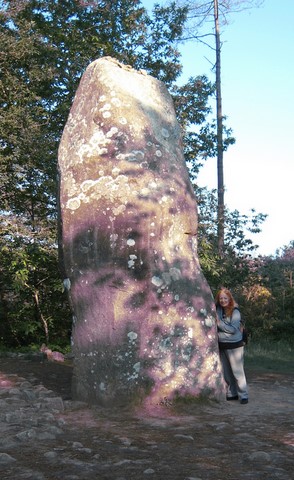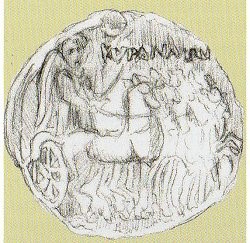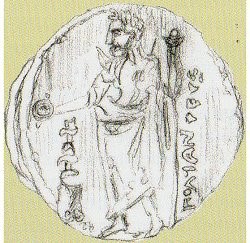Pytheas, megaliths and the tides
by Jean Deruelle
In the 1980s and 1990s, before the word Doggerland came into use, the French polytechnicien and mining engineer, Jean Deruelle (1915-2001), former Director of the coal mining company Houillères de Lorraine, turned his curiosity to the large expanse of sunken land beneath the North Sea, which after the last glaciation had connected Britain to the Continent, all the way to Denmark, and which has since been recognized by scientists as "the true heart of Europe" during the Mesolithic (Richard Bates, University of St Andrews). He suspected that it may have been ancient Atlantis, and that some knowledge and technologies may have originated there, before reaching the Middle East via the Balkans, as recent, puzzling reevaluations of C14 datings seem to show. ("Thomas" is the author's alter ego.)
See: Q-Mag.org: The Great Plain of Atlantis - was it in Doggerland?
Diodorus Siculus, a Greek historian of the 1st century BC, referring himself to Hecateus of Miletus, the first geographer, of the 4th century BC, states:
“Hecateus and a few others claim that, beyond the country of the Celts, there is in the Ocean an island no smaller than Sicily. It stretches Northwards and is inhabited by the Hyperboreans. They are so called because they live beyond the lands where Boreas, the North wind, blows…
Leto is said to have been born on that isle. This is why Apollo, Leto’s son, is the god most honoured there… From this island, the Moon appears to be at a short distance from Earth and is said to display mountains, clearly visible, as there are on Earth. Every 19 years, the god is to come back, to visit the isle. After this time, the stars return to their primitive positions. This is why among the Hellenes, too, a duration of 19 years is called the year of Meton.”[Diodorus Siculus, Universal History, II-47]
Diodorus cites his sources (which may have come to him from Hecateus):
“In very ancient times, a Hyperborean called Abaris is said to have come to Greece to renew the friendship and kinship with the Delians [Apollo, son of Leto, was born on the island of Delos]. Several Hellenes are said to have also gone to that country, leaving offerings there and Hellenic inscriptions.”
A god pays a visit, implying important ceremonies, every 19 years to an island in the North, where the Moon appears at a short distance (i.e. height above the horizon) from Earth. More than that! The text gives us to understand that the Greek notion of the 19 years cycle came from the Hyperboreans, with whom there had been contacts established since “very ancient times,” whereas Meton proclaimed the 19 years law at the 432 BC Olympic games, long after the time of Hecateus.
Although the Greeks may not have gotten the lesson quite right. The 19 year Metonic cycle is the one which brings back the Full Moon to the same calendar day. It is after 18.6 years that the Moon’s trajectory finds back to the same position in relation to the stars (when the stars return to their "primitive" position). The Moon’s orbital plane, as it happens, pivots in relation to the stars by 0.053° per day, completing a full revolution in 6,793 days, or 18.6 years. But the 18 years and 11 days cycle of the return of the Moon eclipses was probably also known to astronomers who had been able to calculate the two former cycles. Could the Hyperboreans have pierced through those secrets long before the Greeks? or the Chaldeans?
19 years + almost 19 years + almost 18 years, total 56, the number of the Aubrey holes at Stonehenge, which puzzle experts so much. (A circle of 56 equidistant holes around the Stonehenge temple, suggesting that wooden posts had been stuck in them.) Could it be that the events of these three respective cycles were checked with a notch every year, on three neighboring poles, thus obtaining a lunar calendar of extreme precision?
Megaliths
Aubrey Burl, in The Stone Circles of the British Isles, studied the 120 cromlechs of Scotland, grouped over a few square kilometres near Aberdeen, on desolate heights along the North Sea. Their diameter varies between 15m and 30m. The most ancient contain ten menhirs. Between the two largest, in the direction of the South, an enormous slab weighing from 12 to 30 tons is laid, with its upper side horizontal. These works are dated between 1700 and 2500 BC.
Astronomical alignments have been sought, in order to explain this peculiar configuration. Nothing convincing was found. What would have been the use of observatories in areas where there is no sign of permanent habitation? The presence of some charred bones evokes tragic, occasional human sacrifices and suggests to Burl a grandiose stageplay. The cromlechs would be round theaters, the stage of which would be the flat horizontal slab framed by the two menhirs. But what was the show? Burl offers that, at these high latitudes, the full Moon made a striking effect, passing very low on the horizon, on June 21, at only 3.35° above the horizon at the meridian, grazing the slab. 90° minus 57.5° (latitude) minus 24° (declination) minus 5.15° (inclination of the Lunar orbit) = 3.35°
Okay! thought Thomas. But a spectacle can impress only if it is exceptional. A full moon comes back every 29.53 days and its aspect is hardly any different a day or two before and after. Otherwise impressive would be a lunar eclipse!
An eclipse occurs when the Moon crosses the shadow cone of Earth. The Moon must be full, which happens every 29.53 days. It must also be on the prolonged Sun to Earth axis, which occurs every 173.3 days. So that, if one total eclipse of the Moon has been observed, one can predict that it will occur again after a number of days which is a multiple of 179.3 and 29.53. Approaching multiples occur two or three times a year, giving partial eclipses. It is the 6.585th day (after 18 years and 11 days) which produces the perfect coincidence. Another remarkable coincidence is the one which, after 6.940 days, that is, 19 years exactly, brings back the full moon to the same calendar day, after 235 lunar months.
If there ever was a show at the cromlechs of Scotland, would it not have been a lunar eclipse? It could explain the location of the cromlechs, as far North as possible, the absence of permanent dwellings, the presence of sacrificial remains, the number of “theaters,” each one taking in some 200 or 300 people.
It seemed that megalithism was indeed strongly impregnated with astronomy. Doesn’t legend say that Atlas, the Titan, who was holding up the vault of Heaven at the North Pole, was the first astronomer? But what powerful motive could have incited these primitive peoples to be so closely interested in the Sun and Moon?
Carnac alignments -
also: Q-MAG.org editor with 6m menhir Géant du Manio (Carnac, 2008)
A thought occurred to Thomas: the tides, this phenomenon which goes by almost unnoticed in most seas of the globe, especially in the Near-East, but which takes on enormous proportions in the northwest of Europe. The movement of the waves reverses itself, harbors empty, hundreds of yards of sea bottom become uncovered, confronting seamen with very difficult problems, unknown to their colleagues in other parts of the world. The amplitude - the difference between high and low tides - which rarely reaches 2m on most of the globe, rises to 4m along the coast of Aquitaine, 5m in the Gulf of Morbihan, 6m at Brest, 11m in the Bay of Mont-Saint-Michel, then down again to 5m in the Pas-de-Calais. The effect is analogous along the coasts of the English Channel. In the Irish Sea, the effect reaches 12 to 13m in the Bristol channel – the height of a four to five story building!
The North Sea is the theatre for curious phenomena. The tidal wave which followed its path through the Northern Atlantic folds back in the south-east, between Scotland and Norway, with amplitudes around 3m. At the mouth of the Thamse, it hits against the wave moving out of the Pas-de-Calais, and turns around, joining with the latter to move up the Belgian coast. The amplitude decreases and no longer reaches more than 1m at Hamburg. These movements leave, in the middle of the North Sea, a zone where tides are close to zero.
Thomas noticed that the great megalithic observatories were all implanted in zones of strong tides. Carnac commands over the Atlantic Coast, and particularly over the difficult entrance to this interior sea which is the Gulf of Morbihan. The Great Menhir of Locqmariaquer (23m high, 347t, the height of the obelisk at Place de la Concorde, but 117t heavier!) surely served as a landmark to seamen, just as today the churchsteeple of Larmor-Baden. As for the “astronomic computer” of Stonehenge, it is situated halfway between Bristol and Southampton, the two points on Earth which (along with the Bay of Fundy in Canada) experience the strongest tides.
And everyone knows that tides are due to the combined attractions of the sun and the moon. All sailors of western Europe have in their pockets the Timetable of Tides, which indicates the “establishment” of every harbour, meaning the delay existing between high tide and the passage of the Moon at the meridian. The priests of the megalithic temples were experts in ceremonies. But their role might have been especially to inform sailors about the movements of the sea.
Logical supputations! But how to bring even a beginning of proof? Thomas found it in the account of Pytheas.
Pytheas of Massalia
Around 320 BC, the Phokean city of Massalia, now Marseilles, put in charge its best sailor, Pytheas, of exploring the northern seas of the Atlantic Ocean. Having come back in fine fettle together with his galleys, he wrote a book about his trip, Peri Okeanos, "Around the Ocean,” unfortunately lost. His work had a large impact, for his exploit remained unique. Four hundred years later, the Romans would go no further than the Elbe and Scotland, hugging the coast. Beyond, Latin writers would be content citing Pytheas. Luckily, they did so abundantly.
There is a consensus in attributing to Pytheas the discovery of the correlations between the tides and the movements of the Moon. Out of the question! Thomas tought. As a prominent Greek from Massalia, Pytheas would certainly have assimilated all the science of his epoch, and therefore he would have been in total ignorance of the whole matter at the time of his departure. And here he is coming back with a theory so exact that it will serve as a law for centuries. However, having left in Spring, he wintered somewhere in Britain and came back to Massalia the following autumn. How is one to believe that he could have, in so short a time, figured out and verified so complex a mechanism?
It was a sure guess that it would have been from the seamen of the North that he learned the way to predict tides and even eclipses, which brought him a serious reputation as an astronomer. His account repeats several times: “The Barbarians showed us where the Sun sleeps.” The Barbarians showed to him the "bed of the Sun," meaning “the place which is forever the origin of nights.”
“At Thulé, the circle described by the sun at the summer solstice remains above the horizon. As for Thulé, it has its longest day lasting twenty hours.”
The “origin of nights,” the bed of the Sun, is the place where the sun goes under only shortly before getting up again. Beyond, there is no more night. This happens at the polar circle, presently at a latitude of 66°5, but at Pytheas' time at 66°2 (90° minus the maximum declination, accurately measured by Pytheas at 23°82). Now, between Norway and Greenland, the only land under these latitudes is Iceland, spreading between 63°5 and 66.5°N. From the northern coast of the island, one could therefore see the “origin of nights,” (beyond, there being no more "night"), whereas in the south of the island, where one would land if coming from Britain, the length of day is presently of 20h 30' on June 21. Thomas had therefore no problem accepting the conclusion of Gaston Broche: that famous Thulé, which caused ink to flow almost as abundantly as did Atlantis, can only be Iceland.
Anyway, according to Pliny: “Pytheas went to the island of Thulé, at six days' sailing distance from the North of Britannia,” which fits well with the 900km on a map. He found there “people having come from Scandia, Dumnan, Bergos and Nerigen.” Which one can translate as: Scania (the South of Sweden), Bergen and Norige or Norge (the name of Norway).
So we must render a just homage and credit to Pytheas’ scientific curiosity, which made him risk his galleys on unknown seas, at the mercy of primitive tribes. He found among them no manifestation of hostility, but, in the contrary, he found them disposed to share with him their knowledge. It was surely the desire to verify their incredible statements which pushed him all the way to Iceland, and even farther, until his ship was stopped by the flows of the ice sheet.
It was the Greek and Roman world which refused to believe that barbarian peoples could have wielded over such knowledge.
“They are very simple people," said Pytheas, "very far from that sharp and mean spirit of today. Their way of life is rough.”
So much said in so few words! Pytheas had manifestly found these indigenous people most endearing. But, conversely, he was also able to win their trust and friendship. We are far, here, from the brutality of so many explorers' accounts, from Odysseus to the Conquistadores! He listened to them, and he profited from what he heard. Brave seamen they were, too, who sailed day and night over the world’s most redoubtable seas.
What may we conclude?
At the time of Pytheas, megaliths building had stopped for 1500 years. Tragedies, invasions had shattered the mores and customs. But these tribes which had remained at the fringe of the ancient world had retained useful knowledge and the peaceable spirit of a brilliant past gone. [The past of Doggerland?]
Jean Deruelle, excerpts from his book De la Préhistoire à l'Atlantide des Mégalithes, Editions France-Empire, 1990 (Paris).
Translated and adapted by Anne-Marie de Grazia





